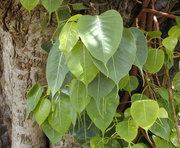Fig
|
|
| Figs | ||||||||||||
|---|---|---|---|---|---|---|---|---|---|---|---|---|
 Common Fig fruit | ||||||||||||
| Scientific classification | ||||||||||||
| ||||||||||||
| Species | ||||||||||||
|
About 800: |
Figs (Ficus) are a genus of about 800 species of woody trees, shrubs and vines in the family Moraceae, native throughout the tropics with a few species extending into the warm temperate zone.
The genus includes one species, the Common Fig F. carica, that produces a commercial fruit called a fig; the fruit of many other species are edible though not widely consumed. Other examples of figs include the banyans and the Sacred Fig (Peepul or Bo) tree. Most species are evergreen, while those from temperate areas, and areas with a long dry season, are deciduous.
A fig fruit is derived from a specially adapted flower. The fruit has a bulbous shape (an accessory fruit called a syconium) with a small opening (the ostiole) in the end and a hollow area inside lined with small red edible seeds. The fruit/flower is pollinated by small wasps that crawl through the opening to fertilize the fruit.
Figs come in two sexes: hermaphrodite (called caprifigs because only goats eat them) and female. Fig wasps grow in caprifigs; when they mature, they mate, and the females leave in search of immature figs to lay their eggs in. When the wasp finds one, she pollinates the female flowers but will not lay eggs in the edible fig, only in the caprifig. Thus the edible fig ripens without any wasp frass in it.
When a caprifig ripens, another caprifig must be ready to be pollinated. Tropical figs bear continuously, enabling fruit-eating animals to survive the time between masts. In temperate climes, wasps hibernate in figs, and there are distinct crops. Caprifigs have three crops per year; edible figs have two. The first of the two is small and is called breba; the breba figs are olynths.
There is typically only one species of wasp capable of fertilizing the flowers of each species of fig, and therefore plantings of fig species outside of their native range results in effectively sterile individuals. For example, in Hawaii, some 60 species of figs have been introduced, but only four of the wasps that fertilize them have been introduced, so only four species of figs produce viable seeds there.
Figs are also easily propagated from cuttings.
An extraordinarily large self-rooted Wild Willowleaf Fig in South Africa is protected by the Wonderboom Nature Reserve.
See also
External links
- Figweb (http://www.figweb.org/Ficus/index.htm) Major reference site for the genus Ficus
- Fig Fruit Information (http://www.thefruitpages.com/figs.shtml)
- Fruits of Warm Climates: Fig (http://www.hort.purdue.edu/newcrop/morton/fig.html)
- California Rare Fruit Growers: Fig Fruit Facts (http://www.crfg.org/pubs/ff/fig.html)
- North American Fruit Explorers: Fig (http://www.nafex.org/fig.html)
- GodHatesFigs.com (spoof site) (http://www.godhatesfigs.com)


